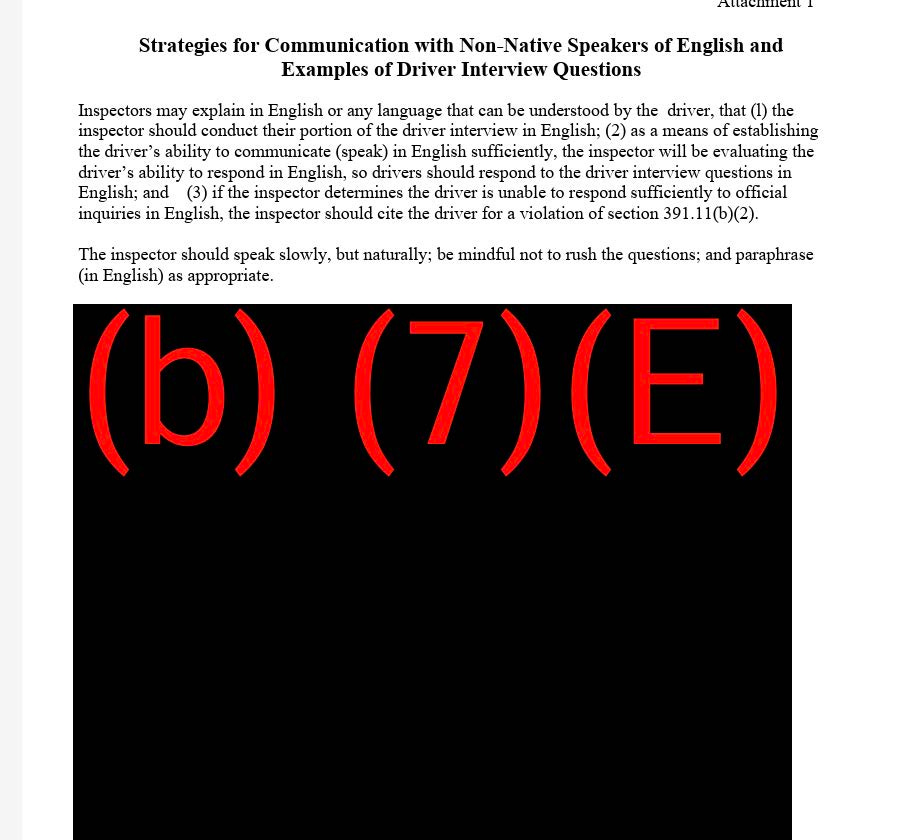Why am I writing about truckers and ELP today?
You may be asking, why is a middle-aged resident of New York City, who presently doesn’t own a car (but proudly spent decades driving the I 95 corridor Boston – NYC) writing about long-haul commercial truckers?
Well… on April 28, 2025 President Trump signed an Exec Order 14286 - “Enforcing Commonsense Rules of the Road for America’s Truck Drivers,” this guidance, effective as of May 20, 2025. Trump stated that he wants to enforce the long-standing (1937) Federal law that states that in order to operate a commercial vehicle, a driver must “read and speak the English language sufficiently to converse with the general public, to understand highway traffic signs and signals in the English language, to respond to official inquiries, and to make entries on reports and records.”
Yesterday, May 20th, the Federal Motor Carrier Safety Administration (FMCSA) issued specifics on just how these language requirements will be assessed and enforced. But since the guidance is heavily redacted – not much skin on the bones explaining the questions and items that will be used with truckers, I and others are anticipating and not a bit concerned.
Once again, appealing to “common sense,” President Trump states:
The stated purpose of this order is to acknowledge and protect America’s truckers who, “perform the demanding and dangerous work of transporting the Nation’s goods to businesses, customers, and communities safely, reliably, and efficiently.”
Proficiency in English, (which Trump declared as the official national language in the US ( Executive Order 14224 of March 1, 2025) should be a non-negotiable safety requirement for professional drivers.
They should be able to read and understand traffic signs, communicate with traffic safety, border patrol, agricultural checkpoints, and cargo weight-limit station officers. Drivers need to provide feedback to their employers and customers and receive related directions in English. This is common sense.
To signal the administration’s intent to tighten and enforce the Language Proficiency standard, now, if a driver does not meet the language requirements, h/she will be deemed “out-of-service” – not able to drive. In 2014 a memo from the Obama Administration stated that drivers could be cited for non-proficiency in English but not placed ‘out-of-service’ – truck and driver off the road. According to Lindsay Steves, writing for “Breakthrough”, up to now state regulators were left to decide on a case-by-case basis how sufficient a driver’s English language skills were.
Note: I’ve included a Brief History of English Proficiency for Truckers,* at the end of this article. Brandon Wiseman, writing on the TruckSafe blog has been covering this issue quite well. Yesterday Wiseman pointed out that the public version of FMCSA’s policy memorandum is heavily redacted. In fact, what is missing are the vital details - the specific questions law enforcement will ask drivers during inspections.
Who would argue against safe truck driving? Noone!
Like any person driving on our roads, and especially when I’m travelling down the I 95 corridor Boston – New York on a rainy day - I want truck drivers to be some of the safest drivers on the road.
In researching this article, I was surprised to learn that accidents involving large trucks are common. In 2021 alone, a total of 523,796 large truck accidents occurred across the United States. A year prior there were 415,444 incidents.
101,000 truck crashes caused injury in 2020 year with another 4,444 causing fatalities. A total of 310,000 of the collisions in 2020 involved property damage alone. Semi-trailers are the most likely to be involved in deadly accidents. And most accidents occur in rural areas.
See the Forbes article for a nice review of stats.
But as I often say in these posts, I’m not going to be writing about that!
I am writing about two things: one I know a lot about, the other I care a lot about.
1. Language and assessing and screening for language proficiency
2. The other, how states and the DOT will assess English Language Proficiency (ELP) for all commercial truck drivers to meet the guidance in President Trump’s April 28, 2025, Executive Order 14286.
Common Sense - Yes
It is common sense that not being able to read road signs for speed, road conditions, brake failure ramps, etc. is a risk. Over recent years there have been some cases where a non-English speaking truck driver caused an accident likely because of failure to read signs. One particular case involved a deadly accident on I-70 near Lakewood, Colorado, on April 25, 2019. The driver of the semi was Cuban-born Rogel Aguilera-Mederos, who did not speak English. At high speed he raced past a yellow highway sign that read, “Runaway Truck Ramp 2000 Feet.” He ultimately plowed through 24 cars and caused 4 fatalities.
https://kdvr.com/on-air/could-i-70-crash-suspect-read-highway-signs-in-english/
Common Sense – Not So Much!
When does someone understand enough in order to do their job and how do we assess that?
To start, let’s get right into the magnificent thorniness of determining if someone is English language proficient.
Look at these 2 “common sense” questions you can pose to patients to see if they can read hospital signs well enough to navigate their way around.
Example #1
You rush into the hospital. Your child 3-year-old son has a high fever and he is having trouble breathing. Which sign will you follow to get to the right place for quick help?
Maternity
Radiology
Emergency Room
cardiology
Cafeteria
The first example is trying to determine if the parent can read and select “Emergency Room”. It is also assessing something about the parent’s health knowledge (health literacy). Does parent know that a 3 year old child with difficulty breathing IS and emergency.
Example #2
Two weeks ago you had a bad fall at work. You went to your clinic uptown and found you had 2 broke ribs. In the last few days you are coughing a lot, and your doctor wants you to have some tests at the hospital. You didn’t write down the name of the department. You enter the hospital and read the signs. Which department do you think you should go to?
Maternity
Radiology
Emergency Room
cardiology
Cafeteria
Example 2 is more difficult, and I think, not a little bit confusing. Does the reader know what the word “Radiology” means? But also, does the reader know enough about health and anatomy in order think that the symptom of coughing might signal an undiagnosed issue requiring, perhaps, an X-ray? I’d argue that “Cardiology” is also a possible choice. Some patients might associate coughing with a heart problem.
The above examples are just examples of over 30 years of experts trying to decide how to assess if people/patients are “health literate’ – have basic ability to read, understand and use health information to make informed decisions. (see references below for the major tools)* The field, like many others, has used and abandoned countless tools to either assess or screen.
I use it simply as a way to introduce how much thought, knowledge, sensitivity and pilot testing ( actually trying questions/tasks out with users) is needed to get things right.
I’m all for common sense but not so much when it comes down to formally, consistently and validly determining if an individual is proficient in a language. Fortunately, my concern is backed with decades of research in the fields of reading, education, ESL ( English as a Second Language), and cognition.
Assessing ELP has also had a very tortured and at times, politically motivated history in this country. Simply recall the nearly impossible “literacy” tests Black southern residents were required to pass in order to vote.
Assess vs Screen
Because assessment is so very difficult ( can write about this in a new piece), over the last decade or two“screening” has been the gold standard, especially in contexts of determining if someone can function, on the job, in a classroom, in daily life.
The function of screening is to identify quickly and easily who does and does not demonstrate XX.
What is Redacted in the publicly distributed Federal Motor Carrier Safety Administration (FMCSA) issued yesterday specifics on just how these language requirements will be assessed and enforced.
I look forward to writing about the quality and appropriateness of the tools/tasks that are going to be used to assess ELP of commercial truck drivers. But right now, I and others are left with a highly redacted report.
According to the US Census Bureau, nearly 18% (thousands) of truck drivers are foreign-born and may not be English proficient. Hastily enacting the new Order without expert and user input could truckers and trucks out of work and off the road.
My Questions: Things to Watch as States Enact ELP assessments
1. What are the specific road signs and other reading materials that will be used and what specific tasks or questions will be asked?
2. What specific methods and language will be used to determine if someone can speak English well enough to perform their job? How do you ensure that these actual spoken statements will be consistently and fairly used by the interviewer? After all we all say things differently – words, tone, body language….
3. Where will these “literacy” tests be administered - in current roadside inspection stations?
4. Would entire companies be required to assess their drivers.
Would these companies, or some other federally funded entiti3s take on the responsibility to offer quality, effective English language training. Research shows that serious gaps exist between what is traditionally taught in adult ELA classes and the actual language demands of work, further education, and training. Fashioning ELP content requires it to be tailored to include job-specific requirements. Traditionally many adult English language acquisition or ELA programs, including English as a Second Language or ESL, have focused on life skills such as banking, shopping, or enrolling a child in school, not reading traffic signs and verbally talking with truck stop weigh station employees.
CODA
No matter what language/s we use, we acquire it continuously over our lifetime to connect, learn and realize our goals and desires. Commercial truck drivers are responsible in great part for the nation’s commerce as well as public safety on the roads we all travel. It will take right-minded, informed and well-intentioned actors promoting and monitoring English Language Proficiency Now to see what sense that actually is.
And, dear readers - if you have any more details about the assessment tools we’d so benefit from hearing from you.
Thank you
Christina
__________________
*Brief History of English Proficiency for Truckers
An English proficiency requirement for interstate commercial truck drivers was first enacted back in 1937. At that time the law was intended to be enforced by the truck company/employer. Who better to judge what communication skills were needed for a specific truck, cargo, route, etc.
Over the years there have been some attempts to tighten or specify the specific language requirements. For example, in August 26, 1997, the Federal Highway Administration (FHWA), predecessor agency to the FMCSA (federal Motor Carrier Safety Administration) , published an ANPRM in the Federal Register (at 62 FR 45200) asking for public comment regards changing the specific language of the requirements to read, be able to “read and speak the English language sufficiently to converse with the general public, understand highway traffic signs and signals, respond to official inquiries, and make entries on reports and records.” 49 CFR 391.11(b)(2)
About that time the ACLU American Civil Liberties Union (ACLU) sent a letter to the U.S. Department of Transportation's Office of Civil Rights indicating that this English language requirement may conflict with Title VI of the Civil Rights Act of 1964, 42 U.S.C. 2000d, The ACLU’s concern, the regulation, as written, was overly broad and subject to arbitrary enforcement, causing potential interference with the constitutional guarantees of due process and equal protection.
The FMCSA concluded that “at this time there is no quantifiable data on which to propose modifying the regulation to require a more stringent or definitive standard, or to require State motor vehicle agencies to administer a specific test for English proficiency”.
FMCSA has long had this rule in place. Still, inspections have rarely focused on it since 2016, when the agency dropped formal language checks during roadside stops
https://allthatsinteresting.com/voting-literacy-test
Some General References
chrome-extension://efaidnbmnnnibpcajpcglclefindmkaj/https://www.fmcsa.dot.gov/sites/fmcsa.dot.gov/files/2025-05/FMCSA%20ELP%20Guidance%20with%20Attachments%20Final%20%285-20-2025%29_Redacted.pdf
Parrish, B., & Johnson, K. (2010). Promoting learner transitions to postsecondary education and work: Developing academic readiness skills from the beginning (Network Brief). Center for Adult English Language Acquisition (CAELA). Washington, DC: Center for Applied Linguistics. Retrieved from https://lincs.ed.gov/ professional-development/resource-collections/ profile-418
Zanyar N, Bareq R. (2023) Factors Affecting Speaking Proficiency in English Language Learning: A general overview of the speaking skill
https://joss.al-makkipublisher.com/index.php/js/article/view/107
For a critique of how we’ve assessed (or not) health literacy, I recommend “Coming to consensus on health literacy measurement: An online discussion and consensus-gauging process”. Andrew Pleasant, Ph.D., and Julie McKinney. chrome-extension://efaidnbmnnnibpcajpcglclefindmkaj/https://lincs.ed.gov/sites/default/files/ComingtoConsensus.pdf
* Various versions of the Rapid Estimate of Adult Literacy in Medicine (REALM), various versions of the Test of Functional Health Literacy in Adults (TOFHLA) two analyses of three screening questions14, 15, the Health Activities Literacy Scale (HALS) the Newest Vital Sign (NVS), Stieglitz 3 Informal Reading Assessment of Cancer Text (SIRACT), Medical Achievement Reading Test (MART), Literacy Assessment for Diabetes (LAD), Nutrition Literacy Scale (NLS), the Short Assessment of Health Literacy for Spanish-speaking Adults (SAHLSA), an instrument targeting Canadian adolescents, a “talking touchscreen” approach, and the 2003 National Assessment of Adult Literacy (NAAL).
I acknowledge and thank Mariah Omadutt (CHES) research assistant, for looking into the history of the ELP laws.








Hi Christina, Could you provide more specifics about appropriate questions authorities could use for truckers?
Excellent points raised